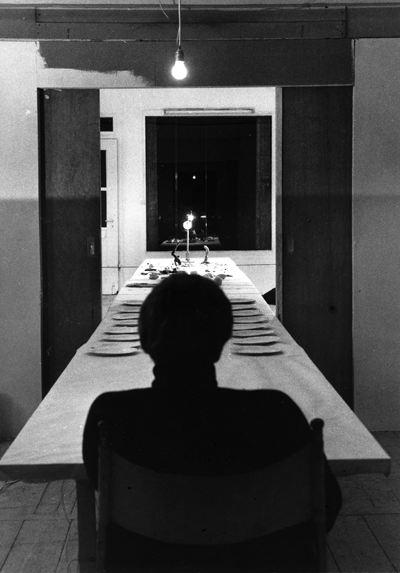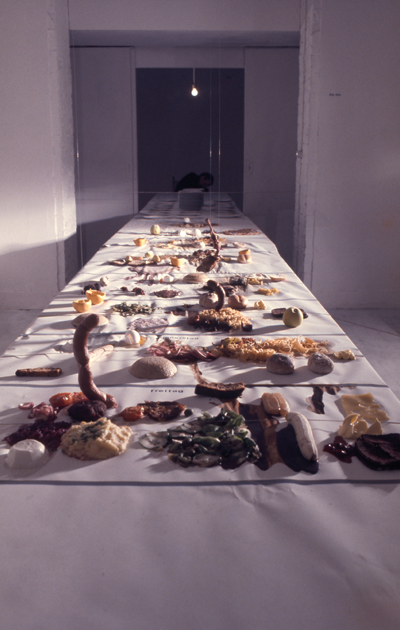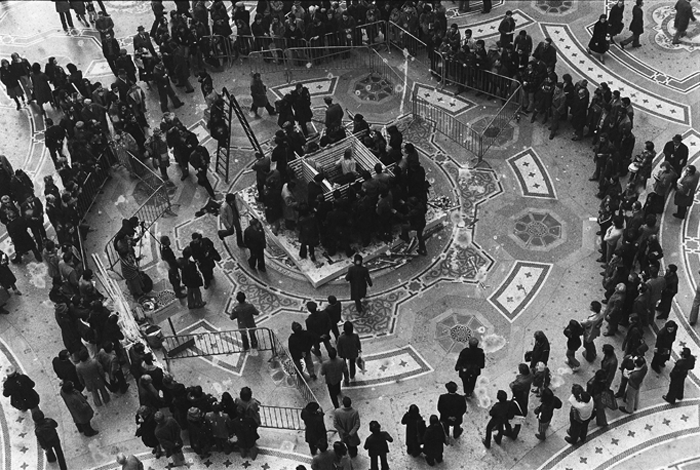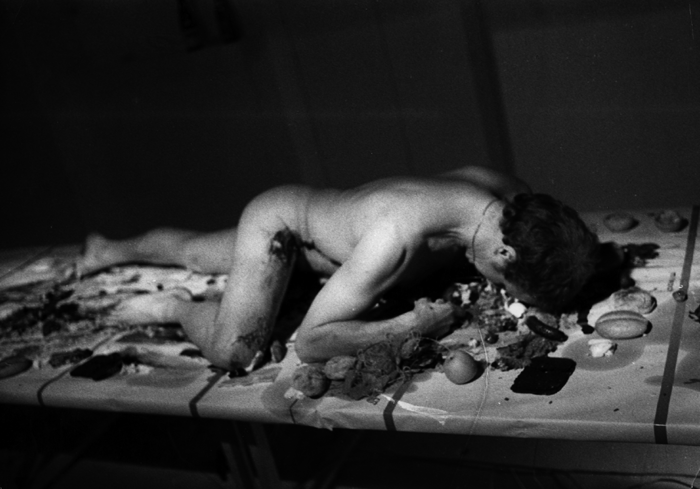Rotten Intervals: Stuart Brisley’s Ten Days
Guest post: Dr Johanna Linsley, University of Dundee
Stuart Brisley, 10 Days, Performance at Editions Paramedia, Berlin, 1973. Photo by Inge Lommatzsch. Courtesy of the artist.
During these last decades the interest in professional fasting has markedly diminished. It used to pay very well to stage great performances under one’s own management, but today that is quite impossible. We live in a different world now.[1]
*
In 1973, between 21-31 December, artist Stuart Brisley didn’t eat. This extended act was the central organising principle of the performance work 10 Days at Editions Paramedia Berlin. Brisley’s website describes the work this way: the artist ‘offered the food he would usually consume to his audience, essentially living without any source of food for the whole 10-day duration of the performance’. The performance was recreated in 1978 at the Acme Gallery in London, also between 21-31 December. Here, the gallery’s layout over two floors prompted the work to take on a specific critical edge ‘as a reflection on Britain’s upstairs/downstairs class system’, as Sanja Perovic writes.[2] Perovic makes the fascinating observation that the duration of 10 Days (a duration that is a signature of Brisley’s work more broadly) has both a practical and a historical basis. Ten days is about the amount of time that it takes food to rot, and it is also the basic unit for the French revolutionary calendar. This coincidence of gross materialism and revolutionary imagination seems key to the work’s significance, just as it is key to understanding the work’s decadence.
A film was made by Ken McMullen of the 1978 iteration, in spite of Brisley’s stated suspicion of documentation.[3] In fact, the film displays its status as document throughout, with the slate clapperboard used to differentiate takes included at the beginning of a number of the scenes. We see a chronological progression of the work, from the first meal to the final remarks given by a master of ceremonies at a closing banquet. In the upstairs gallery space, Brisley sits at the head of a long series of bare, rickety wooden tables. A waiter in a tuxedo undertakes formal service of food which seems indicative of 1970s fine dining (we hear a description, for instance, of an Austrian dish of pancakes and prunes and see the prunes served in liquid in a crystal bowl). Downstairs, a similarly long table is covered in a white tablecloth, and the same waiter at similar intervals lays the table with formal dishware that remains empty of food until the final evening of the performance when an invited audience gathered for a New Year’s celebration. In an interview with Nick Kaye, Brisley notes that his initial intention was to have this be an open celebration for anyone who wanted to attend, but the gallery ultimately decided on a smaller group. He describes, too, the unpredictability of audience response to the work, how after the exhibition received some press, members of the public began to ring the gallery trying to book a seat as if it were a restaurant and that the audience on Christmas eve included two homeless men, who shared the single meal served that evening.[4]
On several occasions through the film, Brisley speaks to the camera, narrating his condition at various points in the performance and making observations on the work as it progresses. At the end of the first day, he notes that he doesn’t feel hungry, which he speculates is because he has observed the food in front of him (a poached egg, half a grapefruit) congealing and withering. The food isn’t appetising so he has no appetite. The following day he notes that the food is, in fact, of very high quality, which creates some problems for the work because visitors are eating most of it and there’s not much left to rot on the table. The chef brings kitchen scraps to bulk up the leavings. Brisley makes some comments on the meaning of the work, suggesting that the work stages an argument against over-consumption and at the same time is a kind of celebration of celebration. This ambiguity seems characteristic of the work, the critical perspective in productive if complex relation to a delight in the festival atmosphere produced over the ten days. The delight in the festive and intense physicality, wrapped up with the importance of the display of decay, draw a clear connection to decadence. However, as I will argue throughout this post, the tension between critique and celebration found in the relationship between festive physicality and the display of decay is also important to account for.
On the ninth day, Brisley observes that fasting has started to take a toll on his mind; whereas earlier on he felt a physical weakness, now he feels a rising hysteria. The final words of the film are spoken by a Master of Ceremonies, who has been briefed by Brisley, though he notes that Brisley’s remarks were not written down, nor did he memorise them. In an almost comically inflated tone, the emcee narrates one of Brisley’s more ‘outré’ comments, a lament that the mountains of shit produced over the course of the year by human beings have not been ploughed into the earth to nourish it, the wastefulness of human waste. Immediately before this scene, we have watched Brisley perform an action with the accumulated food waste on the upstairs table. He undresses and steps onto the table, and then rolls his naked body luxuriantly through the rot (which has also been sprinkled with what seems to be flour).
*
What could be more decadent than choosing not to eat when others starve?[5] The elaborate banquet table is a fundamental scene of decadence – indulgence and exclusion. In Decadent literature, however, abjuring food can also clear the way for more excessive appetites to emerge. In chapter 15 of The Picture of Dorian Gray (1891), the eponymous character – having murdered the artist who painted his cursed portrait and conspired with a doctor to dissolve the body in acid – goes to a dinner party. Seated before a banquet, Dorian cannot eat:
Plate after plate went away untasted. Lady Narborough kept scolding him for what she called ‘an insult to poor Adolphe, who invented the menu specially for you’, and now and then Lord Henry looked across at him, wondering at his silence and abstracted manner. From time to time, the butler filled his glass with champagne. He drank eagerly and his thirst seemed to increase.[6]
The end of the chapter sees Dorian, wracked with terror and other emotions, journeying to an opium den to indulge another hedonistic impulse, each act condemning him more profoundly to the prison of his own self.
Stuart Brisley, 10 Days, Performance at Editions Paramedia, Berlin, 1973. Photo by Inge Lommatzsch. Courtesy of the artist.
*
Jane Desmarais and Alice Condé write in their introduction to the collection Decadence and the Senses (2017) that ‘the tradition of literary Decadence in the nineteenth century stands out for its preoccupation, even obsession, with extreme sensations’.[7] Such sensations are produced not only through over-consumption and self-indulgence but also self-denial; Desmarais and Condé point to Joris-Karl Huysmans’s character Des Esseintes, whose ‘recognizable anorexic tendencies’ are part of an orientation towards the full range of physical sensation from ‘voluptuous pleasures’ to ‘pain and violent disgust’.[8]
Brisley’s work is clearly aligned with such thorough examination of sensation, though he has also rejected decadence as connoting privatisation and individualism. The 1976 work Homage to the Commune comprised a wooden sculpture – ‘symbol of the commune’ – constructed and then demolished by Brisley in public. In a statement accompanying the work, Brisley takes to task an art historical separation of forms and styles that understands performance as ‘a general theatrical condition, which is inappropriate to visual art’.[9] He argues that performance should better be understood as a ‘public exposure of process’, an attention to art’s encounter with the public. To ignore this ‘serves to deflect a real challenge to decadent and seemingly apolitical artistic habits’.[10] Decadence is an obstacle to the commune. Performance in its strongest sense is a declaration of intent to act in solidarity with the collective, the ‘common concern’.[11]
Stuart Brisley, Homage to the Commune, Performance at Palazzo Reale Milan, 1976. Photo by Leslie Haslam. Courtesy of the artist.
In a text by Sharon Behr, Brisley describes how the structure in Homage to the Commune represents ‘the cage in which we live and work from day to day’ and the destruction of this cage at the end of the performance models the need for freedom from these everyday restrictions.[12] The categorisation of art forms, for Brisley, is a symptom of this restrictiveness. But is decadence necessarily the condition of constricted individualism? Brisley’s political horizon is, of course, shaped by its historical position; factors like the Cold War, the cultural upheavals of the 1960s and 70s, and an increasing critique of consumer culture inflect the use of the term ‘decadence’. The opposition of decadence and the collective might appear differently from another angle. Adam Alston, in his blog post ‘On Sick Performance and Theatre’s Chronic Maladies’, argues persuasively for a collective theatre of decadence, for ‘communal stages of all kinds’ where we might ‘open our bodies to new kinds of transmission, sensation and experience’. This understanding of decadence as an opening out from the body seems like an excellent description of Brisley’s aims for performance.
However, it might be useful for a moment to stay with the idea of theatre as a force for restriction. Despite Brisley’s ambitions for it, performance never perfectly exposes process to the public. Theatre has a tendency to creep back in, with its curtains and backstage areas. In 10 Days, for example, while we witness the decay of food out in the open, we don’t have access to the interior digestion processes of those who consume it, and as the emcee at the final banquet notes, the human waste that is produced is not ploughed into the fields but processed out of sight. Interestingly, when Brisley turns his attention to shit directly, theatricality – or at least character – emerges. His early 2000s project the Collection of Ordure was a semi-fictional institution dedicated to defecation. For the project, Brisley developed an alter-ego, R Y Sirb, the curator of the collection and perhaps a kind of deconstructionist deferral accompanying the act of exposure. Where nothing is hidden, still some things remain obscure. Perhaps the theatre – again its backstage, the better to hide decaying portraits – helps us think about the ever-trying, ever-failing promise of performance. Perhaps close attention to the condition of the cage can help us imagine something else.
*
There is another literary reference that opens up questions about decadence, hunger and freedom, if obliquely. At the end of Franz Kafka’s short story ‘The Hunger Artist’ (1922), the virtuosic performer at the centre of the story has become a victim to fleeting tastes, the decadent public no longer able to appreciate the fine art of starvation. Without the capacity to draw crowds to witness his astonishing act as he once did, the artist is reduced to a cut-rate circus where his cage is placed near the menagerie and ignored by punters more interested in the non-human animals. His only consolation is that he is able now to fast beyond the limits previously imposed by his impresario, for reasons of health or good marketing. However, without a witness to this incredible duration, without an external body even to mark how long it lasts, the artist’s triumph is instead a cheap withering. (Perhaps the prototypical occurrence of the problem of performance documentation).
In his last moments, the hunger artist makes a strange confession to the owner of the circus. While he longed for admiration for his incredible ability, in fact, he was due no admiration, because the reason he did not eat was that he never found any food that he liked. This is a moment of sheer oddity, the irruption of personal preference into not only the social but the biological constraints of being. It is an instance of extreme individualism characterised by extreme lack – not only lack of food but lack of appetite, lack of heroism, lack of recognition. It resonates with the Brisley work in its strange flickering between exposure and obscurity, endurance and failure.
The final paragraph takes the story in an unexpected direction. The hunger artist is replaced by a panther, and this panther is a being opposed in every way to the enervated man. Their only shared experience, in fact, is living in a cage.
*
‘Well, clear this out now!’ said the overseer, and they buried the hunger artist, straw and all. Into the cage they put a young panther. Even the most insensitive felt it refreshing to see this wild creature leaping around the cage that had so long been dreary. The panther was all right. The food he liked was brought him without hesitation by the attendants; he seemed not even to miss his freedom; his noble body, furnished almost to the bursting point with all that it needed, seemed to carry freedom around with it too; somewhere in his jaws it seemed to lurk; and the joy of life streamed with such ardent passion from his throat that for the onlookers it was not easy to stand the shock of it. But they braced themselves, crowded around the cage, and did not ever want to move away.[13]
Stuart Brisley, 10 Days, Performance at Editions Paramedia, Berlin, 1973. Photo by Inge Lommatzsch. Courtesy of the artist.
*
Extravagant refusal has a significant place as a performance strategy. In 1971, Lee Lozano, having previously refused to participate in the commercial art world, refused to interact directly with other women, which became a permanent boycott for the rest of her life. For thirteen years between 1986 and 1999, Tehching Hsieh refused to show artwork publicly. Yvonne Rainer’s 1964 ‘No Manifesto’ outlined a series of politically inflected aesthetic refusals (‘No to spectacle’, ‘No to style’, ‘No to camp’, ‘No to moving or being moved’). These extravagances, however, are accompanied by a kind of austerity or minimalism. Brisley’s refusal in 10 Days is by no means austere. I have compared it to decadence both because of its interest in extreme sensation and decay and because of the important questions this conjunction raises about collectivity, freedom, exposure and obscurity.
Ultimately, Brisley’s work has a complex and even uneasy relationship to decadence. Returning to his 1976 statement for Homage to the Commune, he emphasises how important a ‘creative collective statement’ is to the work, while acknowledging how often the intent to produce such collective articulation must fail. However, ‘without such an intention’, he continues, ‘the activity decays to become one of the more obvious aspects of decadent individualism’.[14] Decay, then, is not celebrated for its own sake, but is an unfortunate if pervasive and even predictable outcome of the kinds of situations Brisley constructs. At the same time, it is impossible to ignore the subversive joy to be found in Brisley’s encounters with the rotten, the wrecked, the wasted. In fact, such subversive joy can become the occasion for collective creativity, as many contemporary queer performers have demonstrated so significantly (evidenced brilliantly in posts on this blog by, for example, Jaamil Olawale Kosoko, and Nando Messias and Stephen Farrier. Finally, though, I have argued here that Brisley’s particular brand of decadence – riddled with questions, misgivings and utopian failures – helps stage questions about the continuity between individualism and domination, between (un)freedom and excess. It is a decadence that helps account, too, for productive contradictions, cracks in the edifice.
Notes
[1] Franz Kafka, ‘The Hunger Artist’ in The Complete Stories, ed. Nahum Norbert Glatzer, trans. Willa Muir and Edwin Muir (New York: Schocken Books, 1995), 268.
[2] Sanja Perovic, ‘Dead History and Live Art: Encountering the Past with Stuart Brisley’, Rethinking History: The Journal of Theory and Practice, (2017), 9 http://www.stuartbrisley.com/media/1527960345c4ed921c77cb1.98138423.pdf [accessed 28 July 2021].
[3] Stuart Brisley, Maya Balcioglu and Gilane Tawadras, The Stuart Brisley Interviews: Performance and its Afterlives (London: Bookworks, 2020), 87.
[4] Nick Kaye, Art into Theatre: Performance Interviews and Documents (Amsterdam: Harwood, 1996), 74-75.
[5] The snack-size length of a blog post doesn’t allow, here, for an accounting of those situations where one may be compelled to refuse food because others are starving (among other deprivations), i.e. the hunger strike. Questions, too, of eating disorders, while relevant, are beyond my scope here. See, for example, Patrick Anderson, So Much Wasted: Hunger, Performance and the Morbidity of Resistance. (Durham and London: Duke University Press, 2010).
[6] Oscar Wilde, The Picture of Dorian Gray in Oscar Wilde: The Major Works, ed. Isobel Murray (Oxford: Oxford University Press., 2008), 179.
[7] Jane Desmarais and Alice Condé, ‘Introduction’ in Decadence and the Senses, ed. Jane Desmarais and Alice Condé (Cambridge: Legenda, 2017), 1.
[8] Desmarais and Condé A, ‘Introduction’, 1.
[9] Stuart Brisley, Homage to the Commune – catalogue excerpt (1976) http://www.stuartbrisley.com/pages/29/70s/Text/Homage_to_the_Commune:_Stuart_Brisley_s_statement_in_the_catalogue_for_Arte_Inglese_Oggi/page:18 [accessed 28 July 2021]
[10] Brisley, Homage to the Commune – catalogue excerpt.
[11] Brisley, Homage to the Commune – catalogue excerpt.
[12] Sheila Behr, Text on Homage to the Commune, (1976) http://www.stuartbrisley.com/pages/29/70s/Text/A_text_by_Sharon_Behr_on_Homage_to_the_Commune/page:21 [accessed 29 July 2021].
[13] Kafka, ‘The Hunger Artist’, 277.
[14] Brisley, Homage to the Commune – catalogue excerpt




